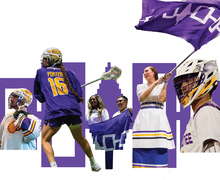SU community reacts to Healing the Scars event on minority perception
A day after about 250 students and faculty assembled in the lower level of Hendricks Chapel to voice concerns about campus self-segregation, racial stigmas and perceived lower standards for minority students, some faculty are working to address these issues.
Sophomore Ronald Taylor, who spearheaded the Healing the Scars event, closed the evening by urging audience members to use the panel as a launching pad to bridge the schisms that attendees and panelists said promote campus self-segregation and discomfort.
Faculty, including Hendricks Dean Tiffany Steinwert, are joining students in continuing this effort. The next step involves helping Taylor organize a sit-in at the Schine Student Center, where students will wear coordinated white shirts marked with the phrase “I will define myself.” Details on the sit-in are expected to be emailed to students in coming days.
“We do have a next step planned, we have a sit-in in Schine. I think that will be an opportunity for the conversation we had in Hendricks Chapel to move outside,” Steinwert said. “It’s something that would confront people that wouldn’t come into Hendricks Chapel.”
On Tuesday, students spoke out about personal instances on campus where they felt stigmatized because of race. Some felt they were considered academically inferior and were expected to speak as a representative of a racial group in classroom settings. The experiences presented by students are not unique to SU, but are indicative of farther-reaching attitudes in American culture, Steinwert said.
“What students were talking about in terms of being tokenized in their classes, having their peers refer to them in ways that were disrespectful or offensive and having people dress up in costumes with cultural appropriation, all of those things I’ve witnessed in the wider American culture,” Steinwert said. “I don’t think those types of attitudes or experiences are any more or less pervasive at Syracuse University.”
Event attendees and panelist Whitney Clinkscales voiced criticism about what theyconsidered an underwhelming presence of white students in Tuesday’s audience. While Steinwert said she would have liked to see more white students in attendance, she said adisconnect in the experiences of minority and white students contributes to this. White students aren’t faced with the racial slurs, stereotypes or tokenization minority students encounter, she said.
Steinwert added that white students may feel uncomfortable or marginalized by attending events centered on race and minority issues. Further education on white privilege is needed to help alleviate this, she said.
“There’s a sense of guilt and shame around white privilege that sometimes paralyzes people from actually engaging because they feel so badly about their position and their privilege that they don’t encounter it,” she said.
But James Duah-Ageyman, director of the Office of Multicultural Affairs, said while event organizers should always strive to coordinate a diverse panel and generate a diverse audience, there is value in minority students speaking to a crowd of primarily minority students. The Office of Multicultural Affairs co-sponsored Healing the Scars with Hendricks.
“It’s OK if we’re preaching to the choir,” Duah-Ageyman said, adding that those conversations can help strengthen and generate interest from students who don’t identify as a minority.
Thomas Wolfe, senior vice president for student affairs, said Tuesday’s panel contributed to conversations that are already in motion on campus. A council of division and inclusion within the Office of Student Affairs was implemented during the summer and is headed by Duah-Ageyman.
Wolfe said the university is forward-looking in trying to anticipate the needs of an increasingly diverse campus and “will prepare for that day in Syracuse University’s future when we will be a majority minority community.”
Published on February 27, 2013 at 11:14 pm
Contact Debbie: dbtruong@syr.edu | @debbietruong





